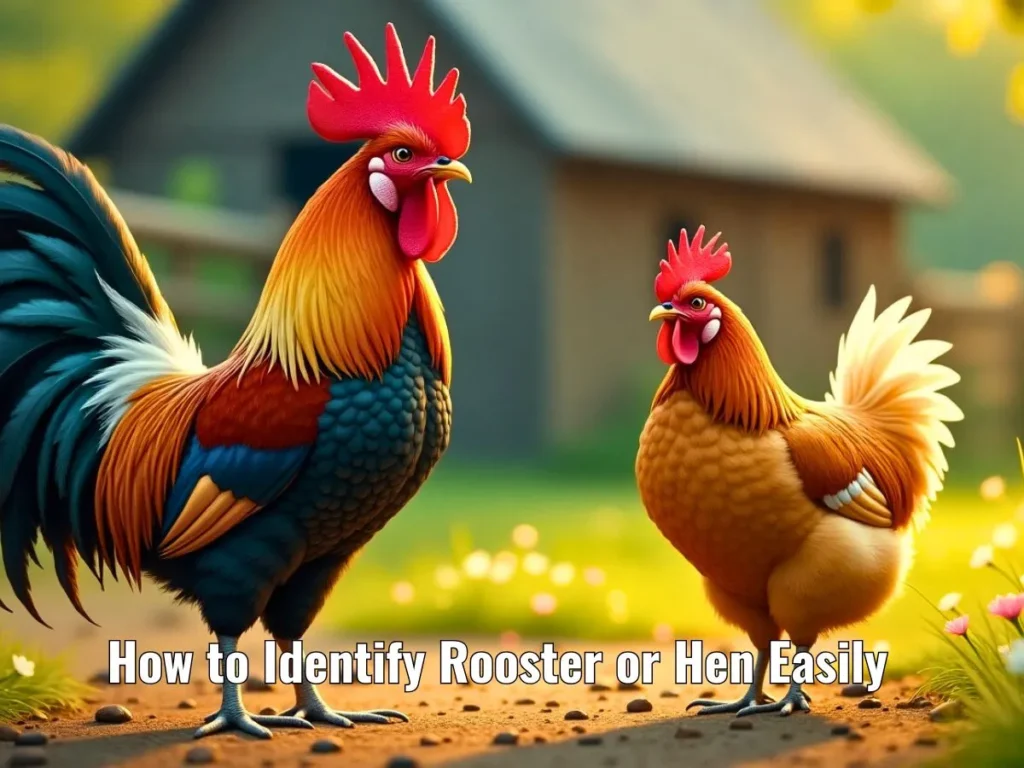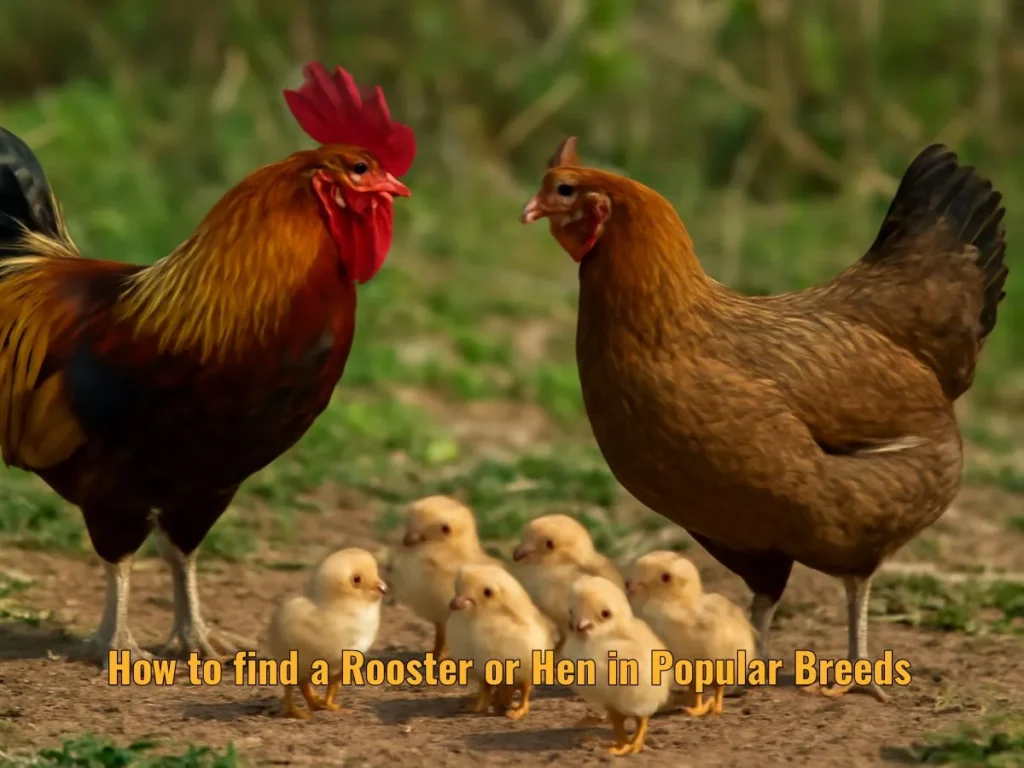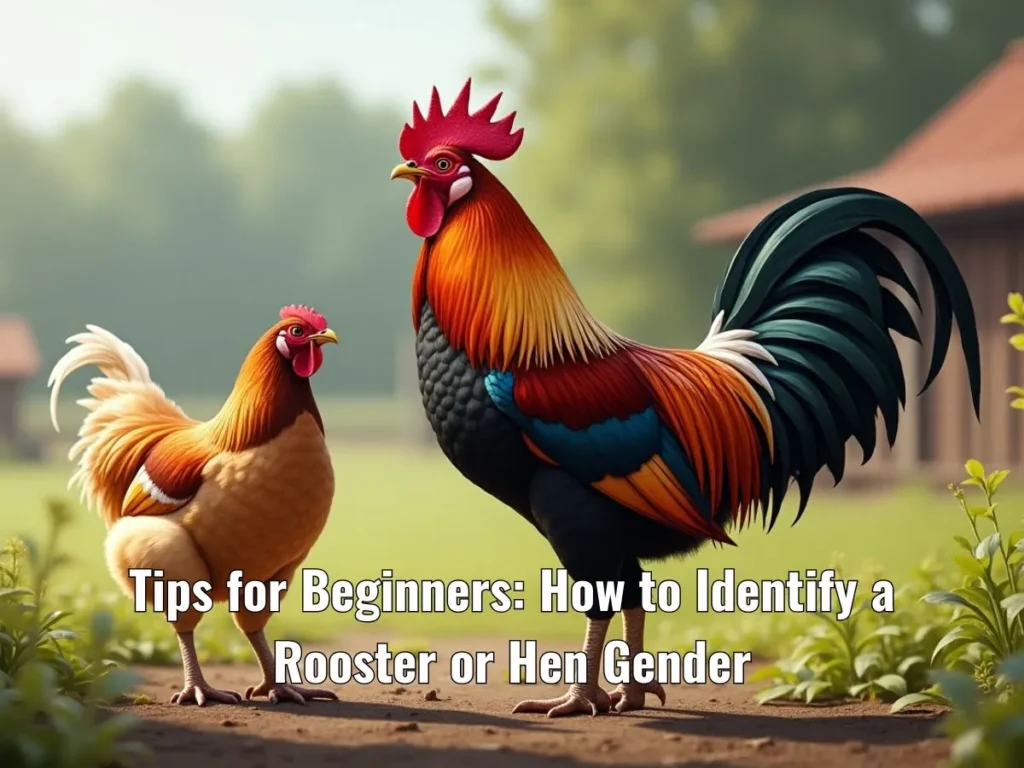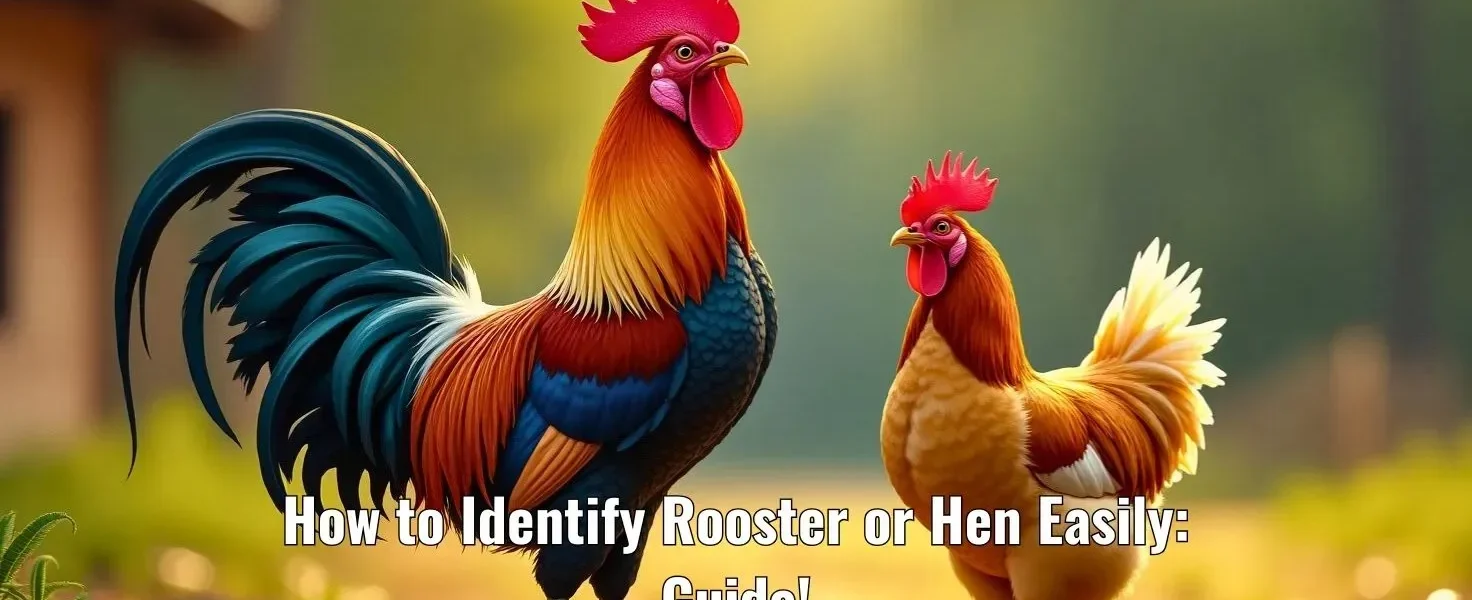The rooster or hen are two of the most gorgeous, beautiful and attractive animals such as birds. To be more specific, they are members and classified in the family of chickens.
They are quite different from one another in terms of their behavior, actions, appearance, features, qualities, characteristics, and personalities.
Hens are used for egg production and raising chicks in both rural and urban agricultural areas. Roosters are in high demand due to their stunning crow and their role in guarding and looking after the flock, which makes them quite popular among hens.
How to Identify Rooster or Hen Easily

In terms of size and height, roosters are generally head and shoulders above hens. It is a fact that their feathers, as compared to the hens, are stronger, colorful, and they have beautiful, attractive, and lovely combs on their heads.
This beautiful comb of roosters differentiates them from other chickens and makes them more attractive in the group of chickens..
In a group, Roosters or hens are very important and necessary, and they do a lot of work for the flock’s productivity. On the other hand, it’s important to have roosters, and they are needed for the group so that the hens can have chicks.
Key Differences Between Rooster or Hen for Poultry Keepers
A person or poultry keeper who keeps Rooster or Hen ought to be aware of the difference between a hen and a rooster because they may produce chickens for eggs, meat, or as pets.
Whenever an individual or a poultry keeper keeps hens or roosters, he/she should maximize the understanding of various traits that distinguish between chickens when they grow up or when they grow old.
Identifying Major Key Characteristics and Physical Features of Hens
Hens have different key characteristics and appearances:
- Hens are covered by feathers, which also assist with keeping them insulated.
- Pecking at food and other items and drinking water with the beak are both ways in which they use their beaks to carry out their feeding activities.
- Hens have wings, which they cannot use for flying; as a rule, they are used for balance.
- The plush protuberance on their head assists them in regulating temperatures.
- The hens have well formed feet with three toes facing frontwards and one posterior, used in scratching the ground.
- The hen has a very short, small feathered tail, and it carries its tail in a standing position, which adds to its beauty.
- Hens can see well in normal conditions, but in the daytime, hens have a very sharp vision.
- There is a hole on the back of a hen that helps in the process of laying eggs and also in the removal of waste.
How to find a Rooster or Hen in Popular Breeds

Here’s how to find and how to tell Rooster or Hen from a chicken in popular breeds:
- Size: It is well-known that roosters are much larger and hens are usually smaller in size.
- Plumage: Hens have feathers that are more muted and more subdued, whereas roosters have feathers that are brighter, shinier, attractive, and more colourful all at the same time.
- Comb & Wattles: Roosters have beautiful combs and wattles, which are fleshy and attractive parts that hang down from their beaks. These combs and wattles are much bigger than those of hens.
- Crows: As far as I know, only roosters can make loud caws in the chicken family.
- Tail Feathers: When compared to the feathers of the tail, hens have shorter, rounder, duller, and chubbier tails, whereas roosters have long, sharp, pointed, and attractive tails.
- Spurs: There are strong spurs on the legs of roosters, however hens don’t.
- Behavior: Roosters are more aggressive than hens, who are more collected, calm, and cool.
Understanding and learn Chicken Behavior and Characteristics
Here’s a quick guide to chicken behavior and characteristics:
- Sociable: Chickens are sociable animals that love spending their time and enjoy being in their own company.
- Pecking: They form and establish a pecking order or chain in order to decide who is the most dominant member of the group.
- Scrating over food: It is common practice for hens to scratch the ground to try to discover food items, such as seeds and insects, while they are searching for food.
- Foraging: They spend most of their time looking, searching, and hunting for food in the natural surroundings around them.
- Dust Bathing: The purpose of the dust bath is to get rid of the mites, as well as to clean themselves thoroughly. The chickens engage in self-dusting.
- Clucking: The sound of hens clucking is especially noticeable and attractive while they are laying eggs or when they are calling to their young and chicks..
- Roosting: Chickens have a wide variety of places where they sleep; perches are one of them. Chickens usually sleep and take rest on perches, which are among the most preferred places for them to do so.
- Egg Laying: Hens lay eggs regularly, usually in the early wee hours of the morning.
- Curiosity: Chickens tend to become naturally interested and will investigate and explore their surroundings on their own will.
- Territorial: They have aggressive and protective behaviour, particularly in nearby areas of their nesting grounds.
The Significant Indicators That Name Whether the Chick is Male or Female
You can identify gender easily whether a chick is male or female by looking at the following important signs:
- Size: In most cases, the normal male is larger and grows more quickly.
- Feathers: The feathers of males develop more quickly than those of females.
- Comb and Wattles: The males developed bigger, redder combs and wattles as compared to the females.
- Crow: Around and between the ages of four and six months, males start croaking.
- Legs: The legs of men can be thicker and stronger.
- Tail Feathers: The tail feathers of males are longer, sharper, and more pointed.
- Behavior: Men are usually more active, strong, and aggressive.
A guide to sexing chicks: vent and feather systems
1. Vent Sexing:
- Procedure: When it comes to examining the chick, the examination is thorough, but special consideration is given to the vent, which is the opening hole through which wastes and eggs are deposited.
- Male: Male has the penis, which is a little round bulge.
- Female: In the case of the female, there is a little entrance, but there is no bump.
Note: Taking this way, which requires some experience and may be difficult for novice players who are just starting, is the approach. Experts mostly carry it out.
2. Feather Sexing:
- Method: According to the patterns of feather growth.
- Male: In most cases, males have longer feathers on their wings.
- Female: Compared to males, females have shorter wing feathers.
- Timing: This procedure is most effective when the chicks are between one and three days old.
Rooster or Hen difference: Size and Appearance differences
Here are the size and appearance hen or rooster difference:
- Size: Chickens normally weigh less than roosters do.
- Feathers: When compared to hens, roosters have feathers that are more colorful, sharp, and bright, while hens have feathers that are more subdued.
- Comb & Wattles: As compared to hens, roosters have their combs and wattles that are bigger and redder.
- Tail: Roosters have tail feathers that are long and pointed, while hens have tail feathers that are shorter, thinner, and rounder.
- Beak: The beaks of roosters are more prominent, larger, and thicker when compared to hens.
- Legs: Hens have thinner and slimmer legs, whereas roosters have bigger, stronger legs with sharp spurs.
Identifying the Crowing, Aggression, and Mating Behavior of Roosters
Here’s how to identify crowing, aggression, and mating behavior in roosters:
- Crowing: When roosters want to show the power they have, they make a loud crowing sound, which they perform often at dawn and throughout the day.
- Aggression: If roosters feel that they are in danger, they may become aggressive towards other roosters and even hens. This is more likely to occur when they think that they are in danger.
- Mating Behavior: The act of breeding for roosters consists of jumping onto the back of the hen, taking her hair, and doing a “cloacal kiss” in order to fertilize the egg.
The Combs, Wattles, and Feathers of Chickens explained
Combs:
- Located on top of the head.
- Red and fleshy, they help with temperature regulation.
- Roosters typically have larger combs than hens.
Wattles:
- Found beneath the beak.
- Red, fleshy parts that help with cooling.
- Like combs, roosters’ wattles are usually larger.
Feathers:
- Chickens are covered in feathers for insulation.
- Feathers come in different colors and patterns, often brighter in roosters.
- They also help chickens with flight (though not for long distances) and protection from the elements.
Important Care Tips related to Rooster or Hen
Here are some important care tips for roosters or hens:
Roosters:
- Space: They need space to roam; when they are crowded, they get aggressive.
- Feeding: Offer a balanced diet that is rich in grains, greens, and protein.
- Aggression: Be on the lookout for aggressive tendencies toward the hens or other roosters.
- Health Checks: Scan regularly to find out indications of injury, especially fighting.
- Roosting: They should also have a good place to roost high at night.
Hens:
- Egg Laying: Provide a quiet, clean space for hens to lay eggs.
- Feeding: It is important to provide a nutritious diet in order to produce eggs (layer feed).
- Cleanliness: Keep their living area clean to prevent disease.
- Dust Baths: Provide a place for hens to take dust baths, which helps with mite control.
- Health checks: Make frequent checks to ensure no signs of illness or parasites are noticed.
How to pick the best Rooster to add to your Flock
Here’s how to pick the best rooster for your flock:
- Health: Select a nice rooster, which is clear-eyed, has no dirty feathers, and does not appear to be sick.
- Temperament: Buy a non-aggressive rooster that will not attack hens or any other birds.
- Size: Choose a rooster that is similar in size to your hens, as this would enhance high success in mating.
- The feathers: Examine the birds with full and vibrant feathers, which show good genetics.
- Voice: Good loud-crow indicates that he is grown and in good condition.
- Genetics: Find a rooster that has desirable qualities, such as a wide immunity and good offspring in terms of egg laying.
- Age: You should choose a rooster that is at least 6 months old because he will be more mature and he can mate.
Tips for Beginners: How to Identify a Rooster or Hen Gender

Here are some tips for beginners to identify a chicken’s gender:
- Size: Males (Roosters) are normally larger and heavier than females (Hens).
- Feathers: The feathers of the roosters are as bright and colorful, whereas hens have dull feathers.
- Combs and wattles: The combs and wattles of roosters are bigger and redder.
- Tail feathers: Roosters: long pointed tail feathers hens, short round tail.
- Crow: Roosters are the only ones who crow and usually start crowing at 4-6 months.
- Legs: The legs of a rooster are thicker and the spurs are longer; the legs of the hen are slimmer.
The reason Why Roosters Crow and how to make it less Noisy
- Territory: They crow to mark their territory and to warn other roosters.
- Find Mates: A crow’s call alerts males of the presence of the birds.
- Morning Signal: Crowing usually occurs in the morning, thus marking the beginning of the day.
To control noise:
- Restrict OF Dawn: Curtains or lights can be utilized to restrict the time that they crow.
- Give Distractions: Give them something on which to focus their time, whether food or something new, to free up the crowing.
- Keep the Roosters Clear: Separate them from the hens so that they do not behave in a territorial manner.
- Train or Muffle: People will make an effort at training, but it is difficult to do so. To an extent, noise can be minimized through silencing a rooster collar.
Conclusion:
In conclusion, knowing the behavior patterns, physical characteristics, and requirements of the rooster and its hen is important to have a flock that thrives well.
The roosters are used in protection and mating, whereas the hens attend to the laying of eggs. It is easy to know their gender by size, feathers, and behavior.
Your chickens will prosper with good care, attention, and with the problem of crowing put under control.
FAQs:
How to tell a Rooster or Hen?
Roosters are bigger, colorful, and have showy plumage, a large comb on the head, and longer tail feathers. Hens possess small tails that are less vivid and reduced in length. They also crow, and hens do not.
Differences between Rooster or Hen
The rooster is bigger and more colorful, with longer tail feathers, and the hen is smaller, less colorful, and shorter. Roosters also have bigger combs, wattles, and crow loudly in contrast to hens.
Chicks, Rooster or Hen difference
The species collectively are called a ‘chicken’, and a female chicken, which lays eggs, is called a ‘hen’, and a male chicken, who crows and breeds, is a ‘rooster’.
Hen, rooster, and chicks
A hen is a grown-up female chicken that lays eggs, a rooster is a grown-up male chicken that crows and mates, and a chick is a little chicken, either male or female, who has just hatched.
Does the Rooster or Hen determine the breed?
The hen and the rooster both give genetics to the breed. Neither affects the breed individually because both parents play a variable role in determining the trait of the offspring.








